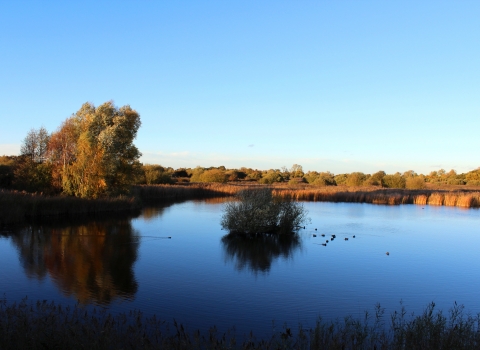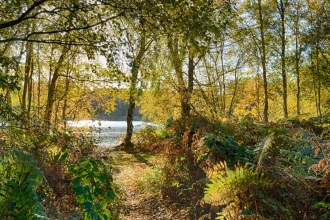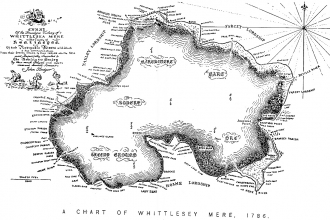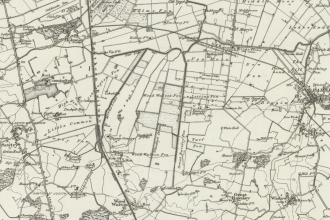500 BC - 200 AD: Romans - the water falls and a road is built
The coming of the Romans coincided with a second fall in water levels and they were able to construct a road across the fens linking central England with what would become East Anglia. The road, the Fen Causeway, was up to 18m wide and was built using gravel to raise it above the marshland. It ran from Peterborough, passing Eldernell and March as far as Denver in Norfolk. There is also some evidence of Roman attempts to drain parts of the fen with sections of the Car Dyke both in Cambridgeshire and in Lincolnshire. A Roman coin of the Emperor Marcus Aurelius 138-181 AD was found in Woodwalton Fen in 1940.
500 - 1000: Early medieval period - monasteries appear and a new dyke helps with drainage
The earliest reference to Whittlesea Mere was in 664AD, when ownership was transferred from the Crown (possibly the Mercian king Wulphere) to Medehampstede Abbey, now Peterborough. At this time Christianity was replacing paganism in England and it was not long before abbeys and monasteries appeared on the islands and the edges of the Fens, for: "these marshes afforded to not a few congregations of monks desirable havens of lonely life in which the solitude could not fail the hermits."
Monastic foundations were created at Crowland, Ely, Thorney, Peterborough, Chatteris and Ramsey and these in turn established dependent cells. The Fens became famed as a home of religion, despite regular interruptions by Viking invaders who targetted these abbeys as they held enormous riches and were virtually undefended. For example, Thorney Abbey was founded in 662, later sacked by the Danes and refounded in 870. Ramsey Abbey was founded in 969 and became a major centre of learning, training monks and scribes and producing beautiful illuminated manuscripts. Its Book of Benefactors described Ramsey as it was when the Abbey was founded:
“The island stretches for some two miles in length…and is garlanded roundabout with alder thickets and reed beds, (and there was) flowering ash for building the church. (The island was) encircled by eel filled marshes… fish and swimming birds”
In about 1020, in the reign of the Danish King Canute, some of his family and servants were caught in a storm on Whittlesea Mere and nearly drowned. It is recorded that Canute caused a dyke to be dug from Bodsey near Ramsey across the marshes to Pondersbridge and on to Peterborough. The dyke no doubt helped a little with the drainage, provided safer travel and could also have been used for moving building stone.
By the time of the Norman invasion many of these monasteries were large and wealthy bodies - Ramsey was the fourth richest in the country. They had acquired between them the greater part of the southern Fenland and controlled the farming, the sale of products and the lives of the people on their lands.
1000 - 1500: Late medieval period - an astonishing quantity of fish
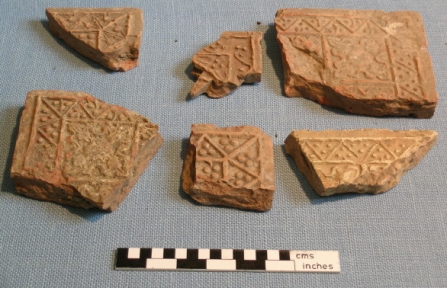
Decorated tiles from Ramsey Abbey. Norris Museum
1070. The Fenland was the last area of England captured by William the Conqueror and it was at the Isle of Ely that Hereward the Wake made his last stand against the forces of the Conqueror.
1083-1130. Ely Cathedral was built with stone from Barnack just north of Peterborough. The stone was transported on sleds to the river Welland and loaded onto barges in which it travelled down the Nene and the fenland waterways.
1086. In the Domesday book, William of Malmesbury wrote: “here is such quantities of fish as to cause astonishment in strangers.” The Domesday Book also recorded that the fishing and mere of the Abbot of Ramsey in Holme parish (part of Whittlesea Mere) was valued at £10, a very large sum in those days. Woodwalton church was mentioned too, but not Ramsey's church and parish as it was entirely owned by the Abbey and so exempt from taxes.The Liber Elienis, a 12th-century English chronicle described: “fish innumerable, eels, large water wolves, pickerel, perch, roach, burbots and lampreys”. The wildlife of the fens in those days must have been amazing.
1100-1135 During the reign of Henry I, Ramsey Abbey acquired the manor of Walton (Woodwalton) with its common rights from Walter de Bolebec. The Abbey was also granted Higney in 1134, a grange with earthworks and a surrounding ditch. Both these places are within the Great Fen area.
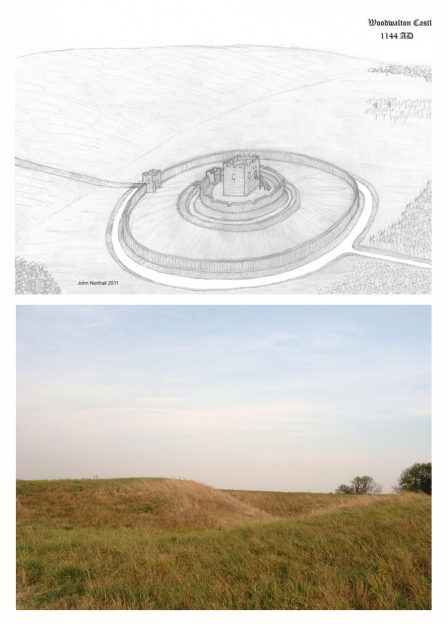
A sketch of Woodwalton Castle as it may have looked, by John Northall and a picture of the Motte today
1135-1150 Eels were so common they were used as currency and for payment of rent. The very name Ely is said to mean “island of eels”. In 1150 the monks of Ramsey paid a rent of 3,000 eels to the monks of Peterborough, for leave to quarry stone which would have been transported by water from the quarries at Barnack, through the river systems, across Whittlesea Mere and on to Ramsey for building work at the Abbey. Sawtry Abbey, founded in 1147 was also very wealthy and often housed parties of nobles travelling on the Great North Road.
1143-44 Geoffrey de Mandeville was a rebel baron who maintained himself and his followers in the fen-country using Ely and Ramsey Abbeys as his headquarters. He expelled the monks, laid waste the surrounding areas, pillaged and burnt the settlements and caused a famine. He and his son illegally built small motte and bailey castles at Woodwalton and Ramsey, where the castle mounds can still be seen.
1150-1300 The first dykes in the Great Fen area appear to have been dug in the 12th century. Monks Lode was dug by the monks of Sawtry Abbey to get stone from the quarries at Barnack for building. To do this they had to cross the lands of Ramsey Abbey, there were disputes about access between the two abbeys. In 1192 the monks of Sawtry undertook not to ''plant trees or fish in Ramsey Marsh'.
Wheatley’s drain was dug at about the same time or soon after. The area of fen now within the Woodwalton Fen National Nature Reserve was owned by Ramsey Abbey in the 13th century and had been drained sufficiently to allow the land to be used for sheep grazing and mowing marsh, but probably only in the summer months. There were two moated manor houses, one in Woodwalton, the moat of the other manor at Great Raveley can still be seen at Raveley Wood Nature Reserve.
1487 Bishop Morton of Ely caused ‘Morton’s Leam’ to be cut in 1487 to aid water flow and water traffic between Peterborough and Wisbech. This was the first straight drain in the Fenland. Although this must have had some effect on the lands south of the Leam (Whittlesea Mereprobably decreased in size) drainage of the area in general deteriorated.
Those few people who lived on the fens at this time had a livelihood based on fish, fowl and building materials. People used stilts, punts and bone ice skates to make their way across the fens. Rights to cut reed were carefully controlled and managed by manorial courts. Willow and reeds were used for building houses and thatching houses.
However, floods were unpredictable and caused many deaths by drowning. Many landowners wished to make the area more productive through conventional agricultural practices, which could only be achieved through large-scale drainage schemes.
1450 -1850: Early modern period - 'Gentleman Adventurers' drain the fens, despite opposition from the 'Fen Tigers'
In the late 15th and early 16th century the Ouse was straightened and a new channel cut from Littleport to Brandon Creek. Water from the fens could now reach the sea more easily.
In 1630 a group of wealthy landowners (the 'Gentleman Adventurers'), headed by the Earl of Bedford, set out to drain the fens so that the peat soils could be used for summer cultivation and to prevent serious winter flooding. The Adventurers would be repaid for their investment by a grant of land. They hired in the Dutch engineer, Cornelius Vermuyden, to mastermind a drainage scheme using drains and wind power. The northern part of Woodwalton Fen was included in these Adventurers lands and was taxed accordingly.
The local villagers were fiercely opposed to the draining, believing it would deprive them of their traditional means of livelihood from wildfowling, fishing and reed cutting and would replace the fenland with arable land owned by strangers. The “Fen Tigers” tore down the dykes, ditches and sluices that had just been built and set the reedbeds on fire, so stopping work. But by the end of the 17th Century much of Vermuyden’s hugely ambitious project had been completed, with the Bedford River and New Bedford River carrying water more quickly northwards to the Wash.
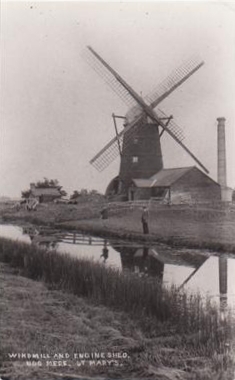
A brick-built windmill and engine shed at Ugg Mere, Ramsey St Mary in the early 20th century.
After the land was drained, the peat started to dry and contract so that the land sank further - leaving the rivers and dykes inside their banks at a higher level than the land. It became necessary to raise the water from the field ditches up into the higher drains. From 1685, windmills, with their great sails were used to power pumps to lift the water. Nine windmills were recorded in Woodwalton parish alone. Later, the pumps were powered by steam, followed by diesel and electricity. Over the years, new sluices and drains had to be built as the land continued to fall.
For a long period early maps show the Great Fen area as a poor wet boggy place. An estate map of 1770 shows the whole of the area south of Whittlesea Mere as either turf fen or wet pasture. The resources of the Great Fen area were carefully managed. Each farm and village along the fenland edge included both tracts of arable land and pasture on the higher land and an area of lower wet land for summer grazing. The valuable sedge crop was taken out from the Fen by boat, as was the turf or peat. By 1820 the villagers were collecting butterflies, moths and bog plants to sell to collectors both locally and in London.
The shallow meres became silted up and landowners realised that if drained and cultivated their value would increase enormously. Ramsey, Ugg and Trundle Meres were all drained by the 1840's, wheat was cultivated for the first time, and their land value increased fourfold.
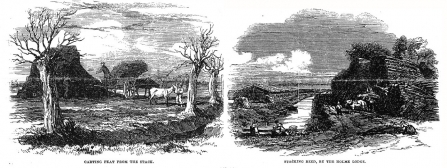
These two etchings, published in the Illustrated London News give a flavour of fen life in the 19th century.
1840 - 1900: Victorian period - steam power arrives and is used to drain the last mere
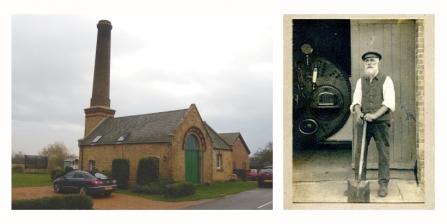
Pump houses were built to house the new steam engines, this one just east of the Whittlesea Mere area has been converted for domestic use. The photo of Elijah Clarke was taken about 1885. He was the engine man at Black Ham engine on the north bank of Whittlesea Mere. (courtesy John Driver)
The coming of efficient steam power in the Victorian age made a huge difference to the whole of the fenland area. The wind-powered drainage mills were gradually replaced by steam powered pumps, often built alongside the old windmills. The steam pumps could be operated in any weather and when flooding was likely they often ran for days and nights on end. Local men became expert in running and managing the steam boilers and their pumps. Another advantage was that water could be lifted over a greater height from the field dykes into the main drains. It was now possible to consider draining the Whittlesea Mere, which was in the northern part of the present Great Fen area. This Mere had become gradually shallower as surrounding areas were drained and it was ‘considered a dreadful nuisance’.
Read more about Whittlesea Mere
The coming of the railways
In 1850 the Great Northern Railway line was laid across the western side of Woodwalton parish and Holme Fen, described as ‘a quaking bog’. A branch line from Holme to Ramsey North was built in 1867, crossing the Great Fen area, which was mostly used to take agricultural produce away to new markets. Several of the farms in the Woodwalton area laid short tramways, as a way of moving produce over the light peat soils to barges, which then went on to a dock at Holme station or elsewhere. The coming of the railways made a big difference to the farmers in the Great Fen area. The line finally closed in 1972.
1900 - 2000: 20th Century - severe floods and disappearing peat put the future of the Great Fen under threat
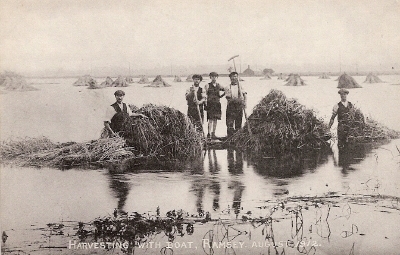
The great flood of 1912 - using a boat in an attempt to save some of the harvest
None of the drainage measures in place could cope with severe flooding, and many parts of the fen land could still be completely flooded. In 1912 it was so wet that the harvest had to be brought in by boat, and in 1947 and 1953 there were huge, devastating floods. Woodwalton Fen still floods in a wet winter.
There is a interesting 9-minute film on the East Anglian Film Archive entitled Draining the Fens that shows the flood of 1947, as well as giving fascinating insights into fenland life as it was nearly 70 years ago.
Arable Farming
For the landowners, the newly created farmland of the fens was extremely profitable. However, it meant a complete change of life for the inhabitants of the fens. In Victorian times, rural poverty became a real issue in the region as there were no longer as many wild birds or the rich fishing in the waterways to supplement peasants' or labourers' diets. Infant mortality rates were high.
However, hundreds of square miles of fenland became highly productive farmland, producing carrots, onions, parsnips, sugar beet, cabbage, wheat and much more on the peat soils or 'black gold'.
There are now about 4000 farms in the wider fenland area with about 14,000 people permanently employed and another 13,000 temporary workers. Despite the best efforts of these farmers, the peat in the farmed areas of the fens continues to erode at an average rate of 2 cm per year. In some areas of the fens the peat has disappeared completely leaving the clay soils underneath.
2001: Modern day - The most ambitious habitat restoration in Europe is launched
At the start of the century, five organisations came together with a vision to undertake one of the most ambitious habitat restoration projects in Europe. With the goal of transforming the landscape in a sustainable way for the benefit both of wildlife and of people.
Find out how the Great Fen Project is transforming the local area now
